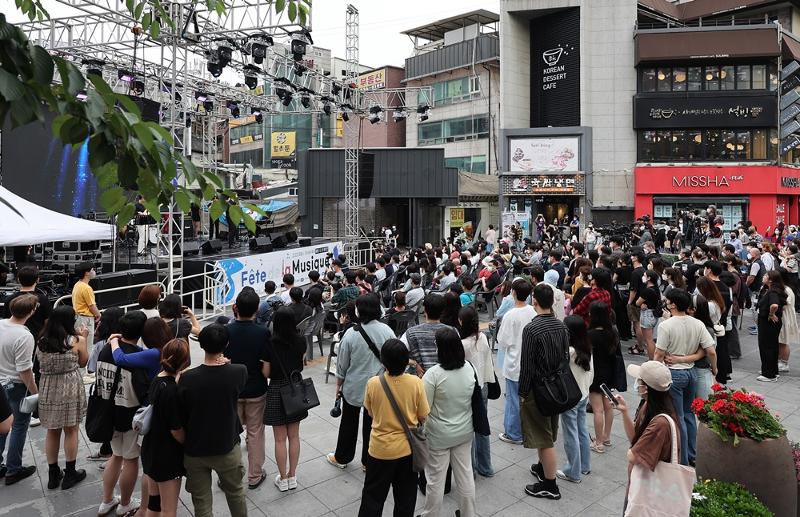
A performance of French street music on June 19 is held on Yonsei-ro Street in the Sinchon area of Seoul's Seodaemun-gu District. (Yonhap News)
By Lee Jihae
The Sinchon area of Seoul is where most foreign nationals in the capital hang out in the afternoon.
The Seoul Metropolitan Government on June 27 released a report analyzing the foreign living population in the capital.
The foreign living population refers to all non-nationals who are in a certain region of Seoul at a given time.
The city government and the Migration Research and Training Centre on April 4 jointly surveyed phone subscribers of the telecommunications company KT. Those polled were long-term residents of Korea for 90 days or more and their relevant data studied were from 3 a.m. and 3 p.m. that day.
The report found that the foreign living population in Seoul at night and in the afternoon was higher than the Ministry of Justice's figure of the registered foreign population of 363,887 as of late March. The population at 3 a.m. (resident population) was 384,036 while the figure at 3 p.m. (active population) was 376,296.
While the ministry's registered population figure was focused in southwestern Seoul (Guro-gu, Geumcheon-gu and Yeongdeungpo-gu districts), the living population was spread evenly throughout the city. It was active throughout the week in select areas like Seodaemun-gu, Mapo-gu, Jongno-gu, Gwangjin-gu and Gangnam-gu.
By dong (neighborhood), the living population was highest in Sinchon-dong in Seodaemun-gu (7,572), followed by Daerim 2-dong in Yeongdeungpo-gu (7,238), Daerim 3-dong in Yeongdeungpo-gu (5,684), Guro 2-dong in Guro-gu (5,627) and Seogyo-dong of Mapo-gu (5,597).
Sinchon-dong, home to Yonsei University, and Seogyo-dong, where Hongik University is located, are considered the main college towns in Seoul. Daerim 2-dong and 3-dong are where ethnic Koreans from China are concentrated.
The evening active population was the highest in Daerim 2-dong in Yeongdeungpo-gu (12,221), Guro 2-dong of Guro-gu (9,831), Daerim 3-dong of Yeongdeungpo-gu (8,000), Sinchon-dong of Seodaemun-gu (7,189) and Jayang 4-dong of Gwangjin-gu (6,688).
The analysis showed that the foreign population tends to gather in areas based on nationality or language. Ninety percent of non-nationals in the city's southwestern region were Chinese speakers, while the English-speaking population was high in Yongsan-gu, Seocho-gu and Gangnam-gu. Mongolian speakers showed an increase in population in the city's eastern region like in Jungnang-gu, Gwangjin-gu and Seongbuk-gu.
Professional workers showed a relatively high concentration mainly in Yongsan-gu, Seocho-gu, Mapo-gu and Gangnam-gu. International students were highly represented in areas with colleges such as Dongdaemun-gu, Seodaemun-gu, Seongbuk-gu, Gwangjin-gu and Gwanak-gu.
By age, high percentages of foreign 20-somethings were found in areas near colleges such as Dongdaemun-gu, Seodaemun-gu, Seongbuk-gu, Gwangjin-gu and Jongno-gu. The number of foreign residents in their 30s to 40s was high in Yongsan-gu, Gangnam-gu, Seocho-gu and Songpa-gu. Southwestern Seoul had a high foreign population of 50-somethings in showing an aging trend.
Kim Seon-soon, head of the city's Women and Family Policy Affairs Office, said, "The living population is a piece of statistical data that offers a better grasp of the supply and demand of urban administrative services than data on the registered population gathered through administrative statistics," adding, "Based on this survey's results, we will prepare and actively push policies tailored to the characteristics of the foreign living population concentrated in each autonomous district."
jihlee08@korea.kr